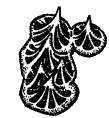Order Echinorhiniformes:
Bramble Sharks — 2 species

- enlarged, thorn-like denticles scattered over the body (the group's scientific name means "hedgehog shark")
- five pairs of gill slits
- two spineless dorsal fins, located far back on the body (the first arising behind the origin of the pelvic fins)
- lack of an anal fin
- ovoviviparous
- exclusively marine, inhabiting deep water from cool temperate to tropical zones of the eastern Atlantic, Pacific, and Indian oceans
- a single genus (Echinorhinus) in the family Echinorhinidae

|

|
|
|
|
|
A representative echinorhinoid, the Prickly Shark (Echinorhinus cookei) displays the salient characteristics of the group: two spineless dorsal fins far back on the body, star-cusped teeth, and lack of an anal fin. Note also the thick caudal peduncle (tail stalk). |
|
Echinorhinoids are rare, rather poorly-known sharks. They appear to be spottily — though widely — distributed, in cold temperate to tropical seas. Bramble sharks typically haunt moderately to very deep waters — from 36 to 2,950 feet (11 to 900 metres). Bramble sharks feed on a variety of fishes living on or near the bottom, including other sharks, elephant fish (a type of chimaera belonging to the genus Callorhinchus), hake, flatfishes, and herrings as well as crabs, octopuses, and squids. Of stocky build with a moderately-sized mouth, bramble sharks are thought to feed by sucking in their prey at close range by suddenly expanding the mouth and pharynx, creating a powerful vacuum.
The Bramble Shark (Echinorhinus brucus) grows to a length of about ten feet (3 metres) and has large, plate-like denticles that often grow together. In addition, fresh-caught Bramble Sharks are usually covered with an evil-smelling mucus. Reproductive data for this species are scanty, but it apparently has 15 to 24 pups per litter. The somewhat larger Prickly Shark (Echinorhinus cookei) grows to a length of 13 feet (4 metres) and has only moderately enlarged, thorn-like denticles that never fuse. The Prickly Shark apparently has much larger litters than its congener — 114 pups (each about 2 feet or 60 centimetres long) were reported in a 6-foot (184-centimetre) specimen from Hawaiian waters. Divers have recently swum with loose aggregations of Prickly Sharks at depths of between 65 and 100 feet (20 and 30 metres) in Monterey Canyon. The sharks seemed strongly oriented to the bottom and canyon walls; at no time did they appear to pose a threat to the divers. Prickly Sharks have also been observed floating almost motionless just above the sea bottom. The reason for this hovering behavior remains a mystery.
 |
 |
Enlarged dermal denticles of the bramble shark (Echinorhinus brucus) — LEFT — and the prickly shark (Echinorhinus cookei) — RIGHT. Note that those of the bramble shark have rounded bases and often fuse together, while those of the prickly shark are stellate with heavily-ridged spines and never fuse. |
Named for the enlarged, thorn-like denticles scattered over the body, bramble sharks were until recently considered to be members of the same order as the dogfish sharks (Squaliformes). The order-level distinction between bramble sharks and the squaloid dogfishes is made on the basis of dental, skeletal, and muscular differences and is supported by molecular evidence (Bernardi and Powers 1992).

